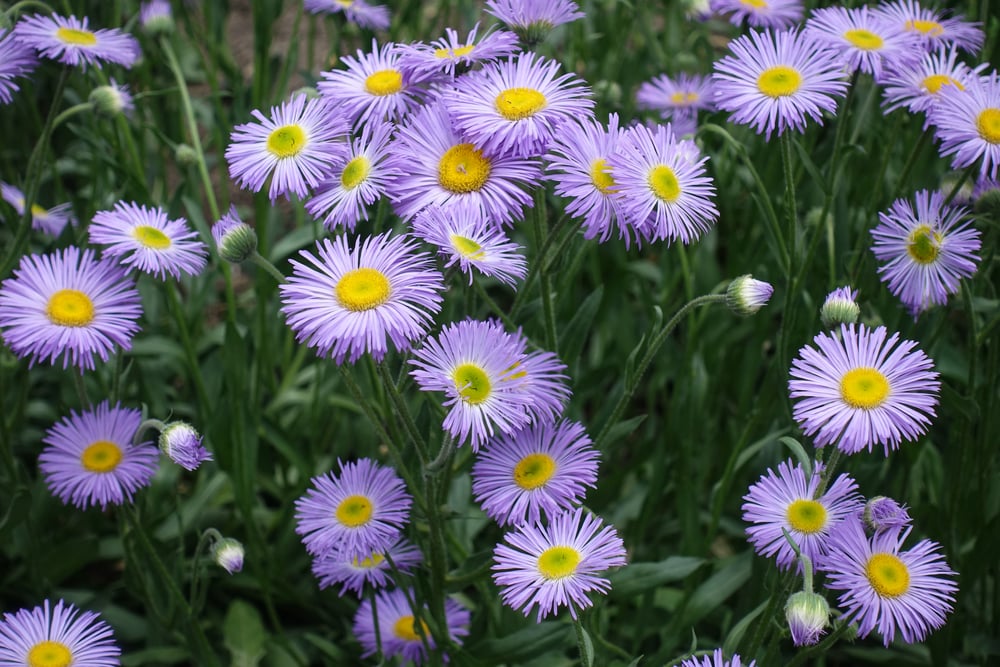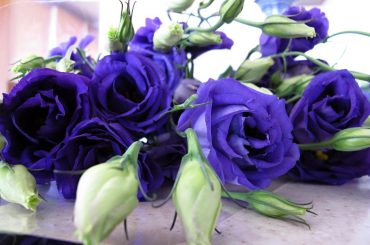Table of Contents
What plants have daisy-like flowers? Flowers usually turn any pale space into a beautiful and bright one. Not only do they go great on windowsills and vases, but they grace the hedges, patio, and borders of the garden. Instead of buying bouquets of your favourite flowers, why not try to grow them in your landscape when it’s made easy? By doing this, you’ll be able to enjoy them swaying in your yard and adding aesthetics all through the year. Garden enthusiasts have also introduced cultivars, i.e., plant varieties with a wide range of colours and bloom shapes that can grow in any condition.
Here is a list of 15 different plants that can be grown in your garden to give you a daisy-like resemblance.
1. Gerbera Daisy
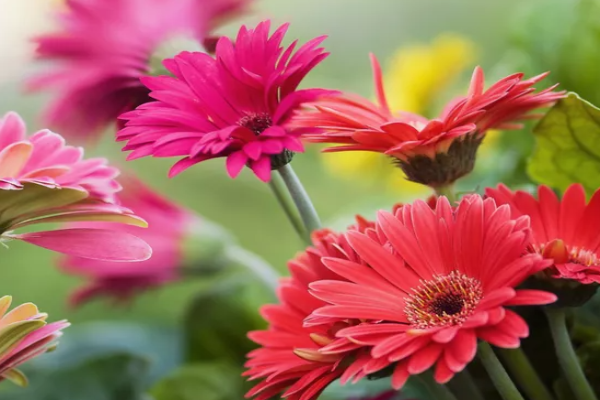
Recognition:
These plants are easy to recognize due to their bright colours; pink, lavender, red, yellow, and orange. Moreover, mature plants grow up to 15-inch height and spread up to 4 inches in diameter.
Type of Plant:
Gerberas is an annual plant that thrives in well-drained soil under warm spots and full sunlight.
How to plant:
The appropriate time for planting gerberas is in late spring. Purchase gerberas online or collect dry seedheads from the flower. Each flowerhead will contain 3 to 6 viable seeds. Prepare the soil with cocopeat, vermicompost, and fungicide and pot the mixture. After moistening the pot mixture, sow the seeds in the pot at a distance of 2 inches. Cover the seeds with dry soil mix and allow them to germinate. Gerberas will bloom after 5 to 6 months from sowing. Till then, water and warm them.
2. German Chamomile
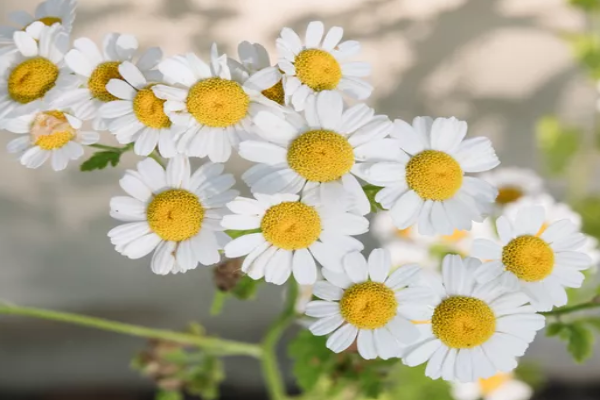
Recognition:
Chamomile is a staple herb and a beautiful flower to add to your garden. These white-petaled flowers with distinct yellow discs can grow up to 3 feet tall. The distinct fragrance of these flowers has made a place in the garden as well as in the kitchen.
Type of plant:
Although the plant is hardy, it requires full sunlight and well-drained soil to bloom.
How to plant:
Chamomiles should be sown in spring. Prepare the seed tray with seed starters, and sow these plants on the surface, as they are light-dependent. Moreover, the seeds are small and dusty in appearance, so just scatter them on the tray. To retain moisture and allow the seeds to receive light, sprinkle some vermiculite. After growing them indoors, move them in the open when your garden has optimum sunlight. Furthermore, the plant will flower in late spring to summer.
3. False Sunflower
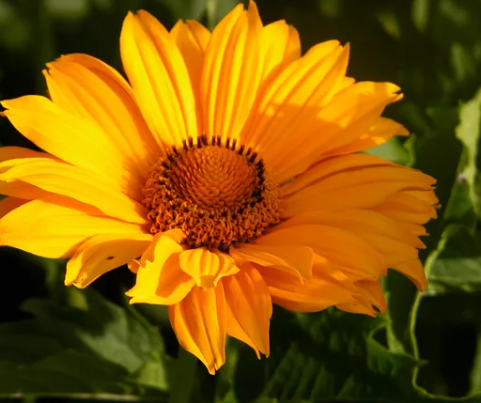
Recognition:
As its name suggests, it is a replica of a sunflower. These plants can grow in orange or yellow petaled flowers and reach up to 5 feet in height.
Type of plant:
Orange sunflowers are very adaptable in nature; they can grow in any soil ranging from black soil to clayey soil and even slightly sandy soil. The plant likes medium to medium dry soil and thrives in full sunlight to slightly shaded areas.
How to plant:
The appropriate time to sow the seeds is in spring. It takes up to two weeks to germinate into true leaves. Orange sunflower seeds can be grown indoors in a container, covered with topsoil, and left in a sunny spot. Furthermore, these plants are capable of growing in dry soils, but during their germination, water them occasionally and provide them with fertilizers. The flowers will bloom in late spring. Furthermore, the stems can be cut down in autumn once flowers have appeared.
4. Pot Marigold
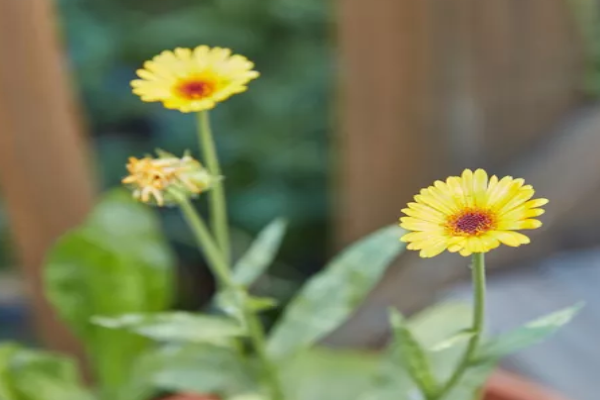
Recognition:
One of the easiest plants to grow with low maintenance, these calendulas are perfect for naive trying to enter gardening. These annual plants come in orange or yellow shades with long stems. Calendulas have the capacity to grow up to 2 feet in height.
Type of plant:
These short perennial plants can grow in pots, containers, and even outdoors. These calendulas look beautiful in almost every spot of the house. They require enough light and well-drained soil to thrive. These plants are different from others as they act as living mulch; have a high amount of organic matter.
How to plant:
Sow the seeds in well-drained soil in a pot in early spring to receive flowers in the early summer. After they germinate, before planting them outside, harden the seeds and then transplant them in a warm, well-lit area.
5. Asters
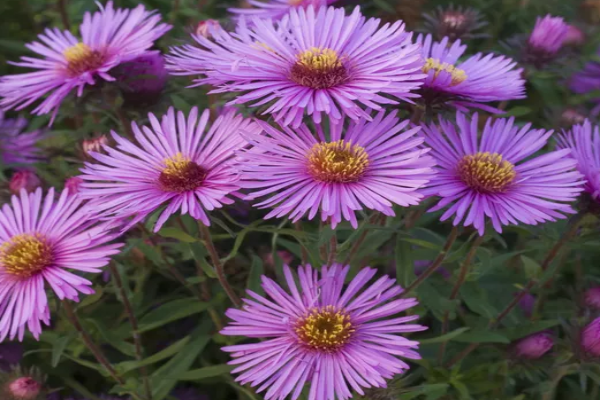
Recognition:
Belonging to the daisy family, these plants can be recognized by their purple to blue coloured flowers. These perennial plants can grow up to 30 inches in height.
Type of plant:
This perennial stays intact from summer to autumn when the surroundings have turned pale. For these plants to thrive, they require moist soil and partial to dappled shade.
How to plant:
These plants should be sown in early spring. Although they require dappled shade when they are planted outside, when they are sown, they require a warm environment to germinate. Use a propagator tray filled with moistened compost. After a few weeks, when the seedlings bear true leaves and the chances of frost have passed, transplant them outside. Asters like to be well-watered all through their growing period.
6. African Daisies
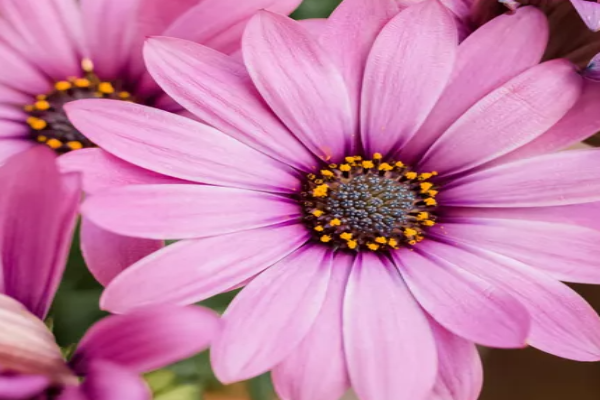
Recognition:
This plant is also known as osteospermum. They have many varieties, but white and purple flowers are the most common ones. These plants can grow up to 3 feet in height.
Type of plant:
These annual plants bloom from summer to autumn and can be sustained in pots, containers, and even as border plants. These daisies require well-drained soil and prefer thriving under full sunlight.
How to plant:
One of the advantages of these daisies is you can collect the seeds from the pre-existing flowers when they dry and plant a whole new one, or you can purchase them. The appropriate time for sowing these seeds is in March, so by early summer, they start flowering. You can start by sowing seeds in a seed starter in a tray or pot. These plants start germinating in 2 weeks. The use of plant food and fertilizers is advised for a good yield and good root system.
7. Marguerita
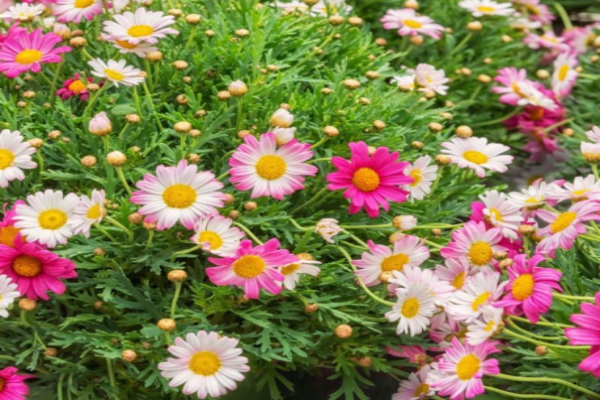
Recognition:
These perennial plants are known for their white, pink, and yellow cheerful blossoms. They have the ability to grow up to 1 meter in height and spread 1 meter in width.
Type of plant:
This plant likes a lot of sun and well-drained soil during its growing period. It can survive in semi-shaded spots as long as it is warm out there. Within these Marguerita, each flower differs in variety and colour. Some petals are singular, while others are in clusters.
How to plant:
The seeds should be sown in spring for bloom in summer that remain till autumn. They are fast growers when provided with adequate light, water, and substratum. Furthermore, they can be planted indoors in pots or trays and placed in a spot that receives direct sunlight. It thrives in moist soil with good drainage and organic compounds like compost and mulch. That will help retain water in summer.
8. Poached Egg Flower
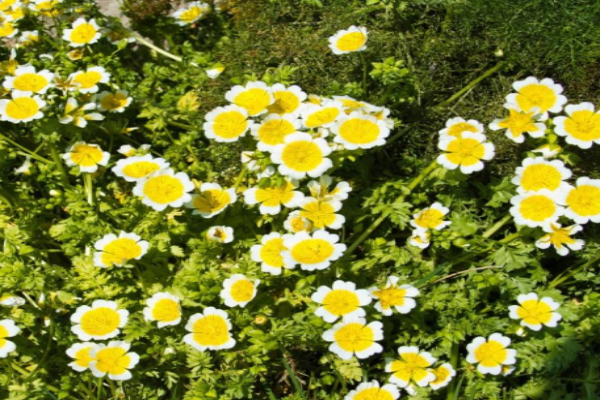
Recognition:
The name says it all! The Limnanthus Douglasii do really look like poached eggs, with beautiful white borders and a yellow centre just like the egg yolk. These annual plants can grow up to 15 cm in height and spread up to 0.5 meters in width.
Type of plant:
Poached eggs thrive in well-drained soil under full sunlight. These fast growers are a huge attraction to many pollinators and prove to be advantageous, as they feed on aphids. This is a great benefit for many gardeners.
How to plant:
The appropriate time to sow the poached eggs is in March, to receive the blooms in June, which continue till the fall. The seeds can be sown in biodegradable pots, containers, and even directly in the garden. The use of biodegradable cans made from cardboard is to avoid root disturbance and directly plant them outside once the frost has passed.
9. Livingstone Daisy
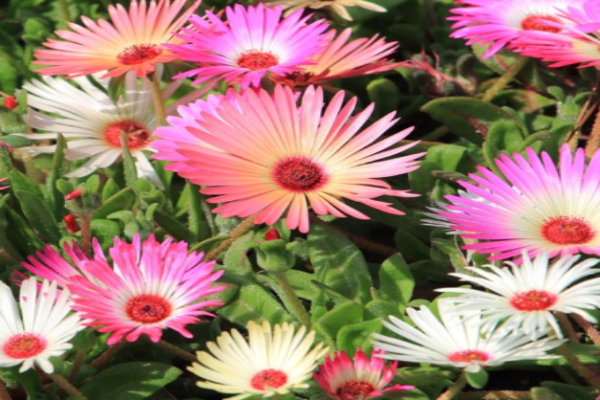
Recognition:
Commonly known as ice plants, these exotic species showcase a frosted appearance. These plants can be recognized by the glistening petal colours that range from orange, yellow, pink, and purple. These plants can grow up to a height of 100 cm and spread up to 50 cm in width.
Type of plant:
This annual plant prefers to grow under full sunlight in well-drained soil. They can be grown indoors in containers filled with gravel or rocky soil.
How to plant:
Ice plants are drought-tolerant and possess succulent leaves. It is advised to sow the seeds in February so that you can receive flowers by June. If the sowing is occurring indoors, fill the container with a mix of river sand or perlite in small amounts and vermicompost in huge amounts. As the sowing is occurring early, try covering the container to provide it with the warmth it requires. After a week or more, when the seedlings start bearing true leaves, shift them to a spot where direct sunlight is received. Keep watering them and keeping the soil moistened.
10. Baby Sun Rose
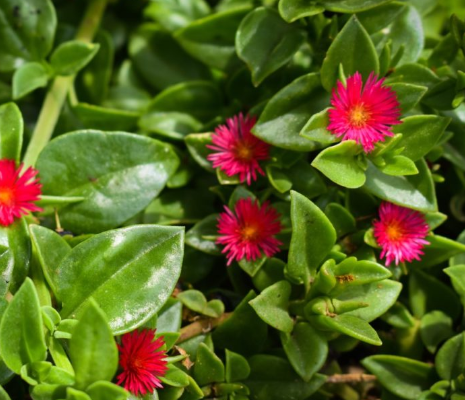
Recognition:
Aptenia cordifolia is an evergreen and fast-growing succulent. Their distinct flowers come in purple to red colour and are small and shiny. Their leaves are fleshy, flat, and heart-shaped, which gives them the common name of the heart leaf ice plant. These plants can grow up to 10 cm in height and spread up to 0.5 meters in width,
Type of plant:
The Baby sun rose is a well-known ground cover. It is an ideal plant for coastal gardens, as it tolerates sea spray and grows in sandy soil. Moreover, it requires full sun to semi-shade to thrive.
How to plant:
These plants can easily be grown from seed and even cuttings. Sow the seeds in spring so they start flowering in summer. Before planting, prepare the garden bed by digging the soil and adding compost, and slowly releasing fertilizers. Once established, it requires less water. But prune it regularly to avoid messy growths.
11. Crown Daisy
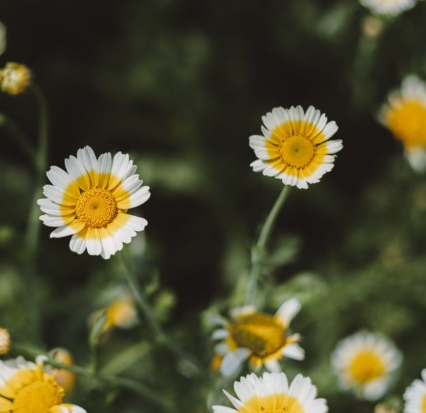
These annual flowers have a distinct yellow centre and white surrounding the petal. The plants can grow up to 1 meter in height and spread about 0.5 meters in width.
Type of plant:
Although these flowers are fully hardy, they require ample sunlight to dappled shade for flowering. As long as the soil is well-drained, moist, damp but not wet, and rich in nutrients and organic matter, the plant can thrive in any type of soil.
How to plant:
It is advised to sow the seeds in early spring. They can be grown indoors in containers and even directly in the garden bed. Sow the seeds in well-drained soil and allow them to germinate in warmth. Keep watering the seeds so that they become permeable. It takes at least a month for the seedlings to develop true leaves. If the chances of frost have passed, these daisies can be planted outside.
12. Firewheel
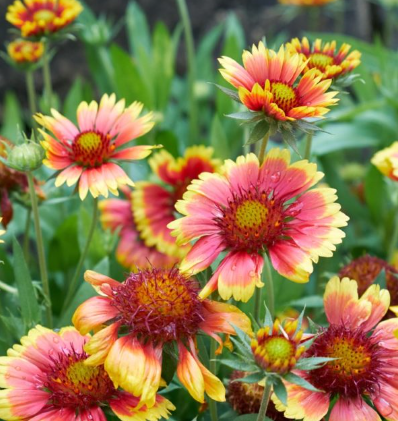
Recognition:
Commonly known as a blanket flower, this plant gets its name from the flower’s look. Gaillardia Pulchella is one of the best summer flowering plants and is heat tolerant too. These plants can grow up to 0.5 meters in height and spread up to 0.5 meters in width. Their distinct red and yellow petals are its key recognition.
Type of plant:
The Firewheel is an annual plant that thrives in the well-drained and fertile sun. In order to bloom, these plants require to be grown under full sunlight. Usually, the flowers survive both in summer and autumn.
How to plant:
Firewheel sowing can be carried out indoors in pots or containers and then transferred to the garden. Seeds can be sown in early spring in a container filled with well-drained soil. The soil bed can be prepared using cocopeat and compost to retain water and grow a good root system.
13. Gazania
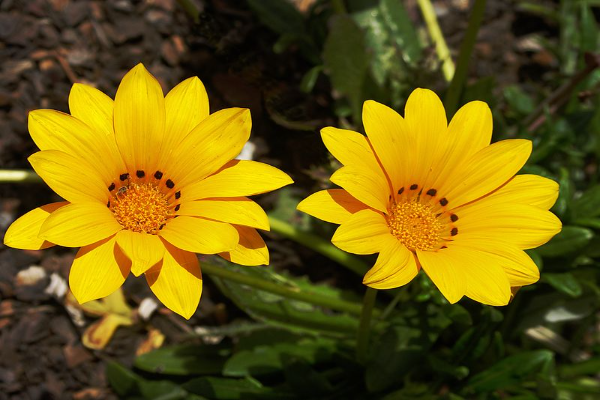
Recognition:
Commonly known as Treasure flowers, these annual plants grow to the fullest, showcasing their different shades in red, pink, orange, and golden coloured petals. They can grow up to 0.5 meters in height and spread up to 0.5 meters in width. Its huge colourful blooms are its key recognition.
Type of plant:
This annual plant thrives in sunlight and requires warmth while germinating. Gazanias can be sown indoors in containers and later can be transferred in the open. A well-drained soil consisting of garden graves is appropriate for their growth.
How to plant:
Gazanias can be sown indoors in early spring to get flowers in summer. Prepare a pot with well-drained soil that consists of garden soil, cocopeat, and vermicompost. Keep the soil moist during their germination. More sunlight provided to the plant, the more the blooms.
14. Compass plant
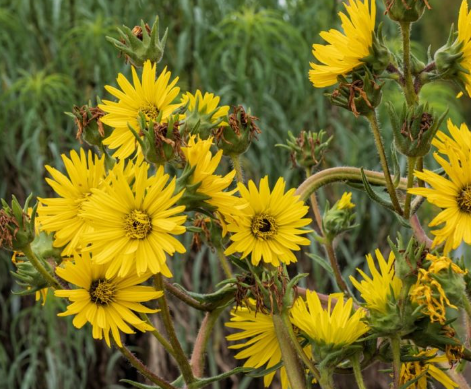
Recognition:
Yellow daisy-like flowers are commonly called pilot plants. This annual plant can grow up to 3 meters in height. A distinct recognition is their aroma. These plants go well in containers, borders, and patios.
Type of plant:
These plants prefer to grow in full sun or partial shade and slightly alkaline, deep, and moist soil. The seeds can be sown indoors and later be transplanted outdoors. The name compass comes from its orientation, north and south, just to try to keep the effects of the sun to a minimum.
How to plant:
Seeds can be sown indoors or even directly in the garden in the spring. They start to bloom in June and continue till August. It is preferred to sow the seed in the garden directly due to its long taproots, which you don’t want to disturb. They prefer loamy, moist to semi-dry, and well-drained.
15. Painted Daisies
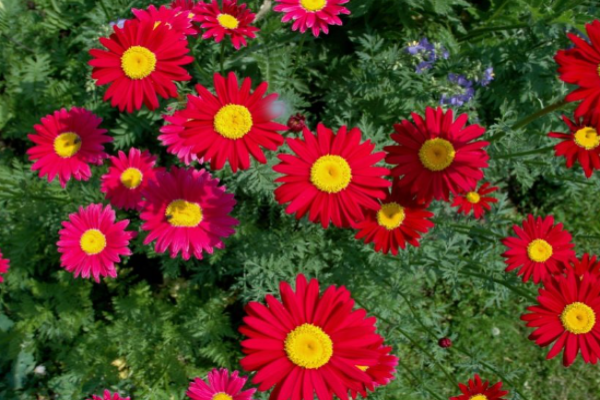
Recognition:
The distinct red, pink, and purple blooms with a yellow centre are a clear recognition. These plants can grow up to 70 cm in height.
Type of plant:
When all threat of frost has gone, directly seed them in rich, well-drained garden soil and full light. Fine dirt should be covered, lightly compacted, and kept evenly moist.
How to plant:
Plant seeds indoors four to six weeks prior to the last spring frost if you’re starting plants from seed. In almost 3 weeks, seedlings will emerge with true leaves. It is an indication of planting them outside. These beautiful types of daisies bloom in summer.
Summing Up
Dreaming about daisies? But why stick to one colour, when you can get a wide range of them? Follow these tips and try to grow them in your container, pots, and gardens. All these varieties go great on borders, patios, and windowsills.
Some of these varieties bloom all through the summer and last till autumn, making the still days even brighter. All you need to do is look after them in the form of pruning and deadheading to promote more blooms. Moreover, shift these cultivars indoors if you reside in high altitudes to enjoy their view by the bed or windowsills.
Share your experience with us on our social media pages. Join our team and train novices in gardening and unique techniques.
Frequently Asked Questions
What Is the Difference Between Asters and African Daisies?
Although both possess similar coloured petals, purple to bluish in colour, the petal size of aster is smaller and thinner compared to African daisies. Moreover, the asters come majority in white, purple, and pink shades, whereas the African daisies come in a wide range of colours. Furthermore, asters are taller and spread wider compared to African daisies.
What Type of Condition Is Required for False Sunflower to Grow?
The appropriate time to sow the seeds is in spring. It takes up to two weeks to germinate into true leaves. Orange sunflower seeds can be grown indoors in a container, covered with topsoil, and left in a sunny spot. Furthermore, these plants are capable of growing in dry soils, but during their germination, water them occasionally and provide them with fertilizers. The flowers will bloom in late spring.

